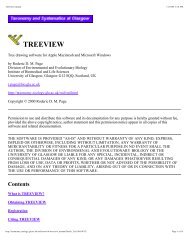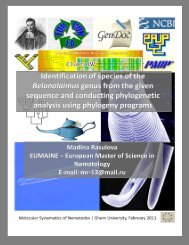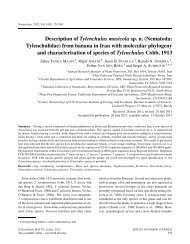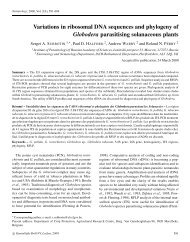Identification of cyst forming nematodes of the genus Heterodera ...
Identification of cyst forming nematodes of the genus Heterodera ...
Identification of cyst forming nematodes of the genus Heterodera ...
You also want an ePaper? Increase the reach of your titles
YUMPU automatically turns print PDFs into web optimized ePapers that Google loves.
Fig. 3. Restriction fragments <strong>of</strong> amplied ITS regions <strong>of</strong> sugar<br />
beet <strong>cyst</strong> nematode <strong>Heterodera</strong> schachtii. (For species code see<br />
Table 1; M: 100 bp DNA ladder).<br />
Fig. 4. Restriction fragments <strong>of</strong> amplied ITS regions <strong>of</strong> <strong>cyst</strong><br />
<strong>forming</strong> <strong>nematodes</strong> digested by Tru9I. (For species code see<br />
Table 1; M: 100 bp DNA ladder).<br />
was also distinguished from all o<strong>the</strong>r species by several<br />
enzymes (Table 2).<br />
Intraspeci c variationwas revealed within some species.<br />
AluI (Fig. 1A) and RsaI (Fig. 2E) distinguishedEuropean<br />
populations<strong>of</strong> H. avenae(type A) from <strong>the</strong> Indian population<br />
(type B). These enzymes partly digested ITS regions<br />
<strong>of</strong> three French populations indicating <strong>the</strong> heterogeneity<br />
in rDNA (Subbotin et al., 1997). Bsh1236I (Fig. 1C)<br />
produced additional restriction fragments for <strong>the</strong> Rinkam<br />
(Bavaria) population<strong>of</strong> H. avenae. These fragments, however,<br />
were not found in o<strong>the</strong>r H. avenae populations(Subbotin<br />
et al., 1999b). The two populations<strong>of</strong> H. salixophila<br />
differed by <strong>the</strong>ir RsaI restriction patterns. This enzyme restricted<br />
<strong>the</strong> ITS regions <strong>of</strong> <strong>the</strong> Belgian population,but not<br />
Identication <strong>of</strong> <strong>Heterodera</strong> species<br />
that <strong>of</strong> <strong>the</strong> Ukrainian one (Table 3). Two populations <strong>of</strong><br />
M. alni differed by <strong>the</strong> MvaI restriction pattern; <strong>the</strong> enzyme<br />
partly digested <strong>the</strong> ITS regions <strong>of</strong> <strong>the</strong> Belgian population<br />
indicating a heterogeneity in this region <strong>of</strong> <strong>the</strong><br />
species (Table 3). Intraspeci c variation in RFLP patterns<br />
was not revealed within H. humuli, H. riparia (Subbotin<br />
et al., 1997), H. lipjevi (Subbotin et al., 1999b), H. iri,<br />
H. hordecalis, H. goettingianaand H. schachtii.<br />
Discussion<br />
The present work con rms that rDNA-RFLP allow<br />
clear differentiation <strong>of</strong> agriculturally important <strong>cyst</strong> <strong>forming</strong><br />
nematode species from each o<strong>the</strong>r and from <strong>the</strong>ir sibling<br />
species. RFLP produced by only seven enzymes separated<br />
21 species <strong>of</strong> <strong>cyst</strong> <strong>forming</strong> <strong>nematodes</strong>(Table 3).<br />
Nematode species in <strong>the</strong> same <strong>genus</strong> are considered to<br />
have similar sized ampli ed products <strong>of</strong> <strong>the</strong> spacer regions,<br />
whereas size variation between genera is accepted<br />
to be common (Powers, 1996, 1997). Our study demonstrated<br />
that <strong>the</strong> size <strong>of</strong> ampli ed ITS productsis ra<strong>the</strong>r stable<br />
within <strong>the</strong> <strong>genus</strong> <strong>Heterodera</strong>. Only for H. cyperi and<br />
H. oryzicola did we obtain a deviating length so that <strong>the</strong>se<br />
species can easily be separated from o<strong>the</strong>r <strong>cyst</strong> <strong>forming</strong><br />
nematode species. Variation in <strong>the</strong> size <strong>of</strong> <strong>the</strong> ITS regions<br />
has been reported for species from <strong>the</strong> genera Aphelenchoides<br />
(Ibrahim et al., 1994), Meloidogyne (I. De Ley,<br />
pers. comm.), and Pratylenchus (Orui, 1996; L. Waeyenberge,<br />
pers. comm.).<br />
In <strong>the</strong> present study we used primers amplifying an<br />
rDNA product including <strong>the</strong> ITS1, ITS2 regions and <strong>the</strong><br />
5.8S gene plus anking areas <strong>of</strong> <strong>the</strong> 18S and 28S genes.<br />
Primers used for ampli cation <strong>of</strong> nematode ribosomal<br />
DNA were recently reviewed (Fleming & Powers, 1998;<br />
Powers & Fleming, 1998). For identi cation <strong>of</strong> some <strong>cyst</strong><br />
<strong>nematodes</strong> species Szalanski et al. (1997) and Fleming et<br />
al. (1998) used only <strong>the</strong> ITS1 region. Although Ferris et<br />
al. (1993, 1994) and Blok et al. (1998), all studying <strong>cyst</strong><br />
<strong>forming</strong> <strong>nematodes</strong>, reported more variation in <strong>the</strong> ITS1<br />
region than in <strong>the</strong> ITS2, <strong>the</strong> use <strong>of</strong> both <strong>the</strong>se regions looks<br />
to be more promising,because after its digestion <strong>the</strong> larger<br />
size <strong>of</strong> <strong>the</strong> PCR ampli ed fragment yields more informative<br />
patterns. Moreover, some restriction sites useful for<br />
identi cation <strong>of</strong> several agricultural important species are<br />
situated in <strong>the</strong> ITS2 region (unpubl.).<br />
ITS regions are considered to be ra<strong>the</strong>r conservative<br />
and so not appropriate for separation <strong>of</strong> populations belonging<br />
to same species. However, intraspeci c variations<br />
in <strong>the</strong>se regions have been revealed within plant parasitic<br />
Vol. 2(2), 2000 161
















